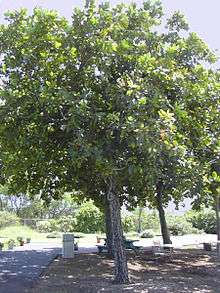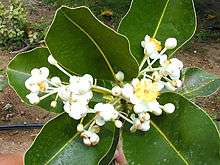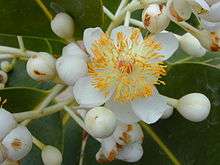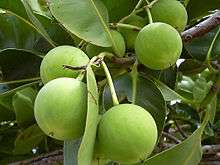''Calophyllum inophyllum'' seed oil




Calophyllum inophyllum seed oil is the oil exracted from the seed of Calophyllum inophyllum, a tropical tree belonging to Guttiferae family. The oil has medicinal value and use as a fuel.
Fruits
Fruiting takes place twice in a year in May and November. The fruit (the ball nut) is a round, green drupe reaching 2 to 4 cm in diameter and having a single large seed. When ripe, the fruit is wrinkled and its color varies from yellow to brownish-red. The weight of the small fruit is 9 to 16.0 g when they are fresh. After drying, the weight is reduced to about 4 g. Ripe and fallen fruits are collected from the bottom of the tree, by beating the limbs with a long hand stick, or hand-picked by climbing the tree.
Kernel
The kernel part in the whole dry fruit comprises 43–52% of its weight. The kernel is 1.5 cm diameter, enclosed in a soft seed coat and a hard seed coat. The kernel contains 55–73% of oil and 25% moisture when fresh.[1]
Seed processing and extraction of oil
The seeds are decorticated by wooden mallets or by decorticators or by pressing under planks. Usually, the kernels are pressed in wooden and stone ghani.[1]
Properties and fatty acids of oil
The oil is bluish-yellow to dark green viscous, known as domba oil, or pinnai oil, or dilo oil. It has a disagreeable taste or odour, as it contains some resinous material that can easily be removed by refining. The concentration of resinous substances in the oil varies from 10 to 30%.[2] The main compounds of the seed oil are oleic, linoleic, stearic, and palmitic acid.
Physical characteristics[1]
| physical character | Range |
| Refractive index 30 °C | 1.460-1.470 |
| Iodine value | 79-98 |
| Saponification value | 190-205 |
| Unsaponifiable matter | 1.5%, maximum |
| Acid value | 20-40 |
| Moisture | 0.5%, maximum |
Fatty acids present in oil
| Fatty acid | Percentage |
| Palmitic acid | 14.8-18.5 |
| Stearic acid | 6.0-9.0 |
| Oleic acid | 36-53 |
| Linoleic acid | 16-29 |
| Erucic acid | 2.5-3.5 |
Uses
The seeds yield a thick, dark green tamanu oil for medicinal use or hair grease. The first neoflavone isolated in 1951 from natural sources was calophyllolide from C. inophyllum seeds.[3]
The fatty acid methyl esters derived from C. inophyllum seed oil meets the major biodiesel requirements in the United States (ASTM D 6751), and European Union (EN 14214). The average oil yield is 11.7 kg-oil/tree or 4680 kg-oil/hectare. In the northwest coastal areas of Luzon island in Philippines, the oil was used for night lamps.[4] This widespread use started to decline when kerosene became available, and later on electricity. It was also used as fuel to generate electricity to provide power for radios during World War II.
In Southern India, the oil of the seeds of the plant is used specifically for treating skin diseases. It is also applied topically in cases of rheumatism. The oil may have been useful in waterproofing cloth and is used as a varnish. An extract from the fruit was once used to make a brown dye to colour cloth. The oil can also be used to make soap.[5]
In the most of the South Sea islands, tamanu or sultan champa oil is used as an analgesic medicine(natives use it in frictions for sciatica and rhematism) and to cure ulcers and bad wounds[6] A farmer in Nagappattinam district of Tamil Nadu has successfully used the oil as biodiesel to run his 5-hp pumpset.[7]
External links
- Prospects and potential of fatty acid methyl esters of some non-traditional seed oils for use as biodiesel in India
- http://www.dweckdata.com/Published_papers/Tamanu.pdf
References
- 1 2 3 SEAHand Book-2009 by The Solvent Extractors' Association of India
- ↑ http://www.worldagroforestry.org/sea/Products/AFDbases/af/asp/SpeciesInfo.asp?SpID=2
- ↑ Neoflavones. 1. Natural Distribution and Spectral and Biological Properties. M. M. Garazd, Ya. L. Garazd and V. P. Khilya, Chemistry of Natural Compounds, Volume 39, Number 1 / janvier 2003.
- ↑ http://gardentia.net/2012/12/06/undi-4/
- ↑ http://www.svlele.com/undie.htm
- ↑ http://www.dweckdata.com/Published_papers/Tamanu.pdf
- ↑ http://www.thehindu.com/sci-tech/science/using-bio-fuel-to-run-an-irrigation-pump-for-five-acres/article5835856.ece
.jpg)